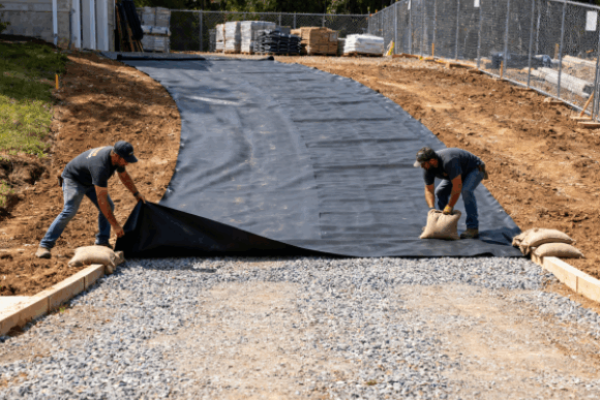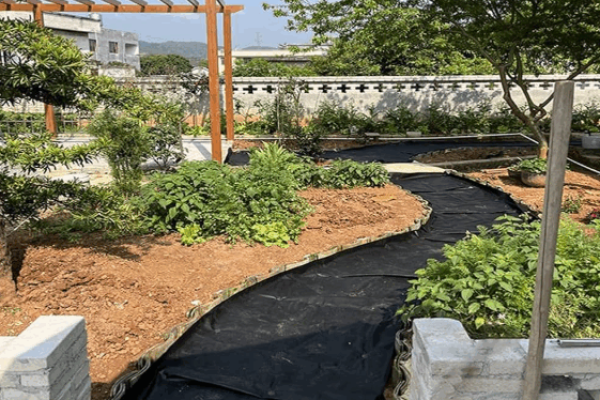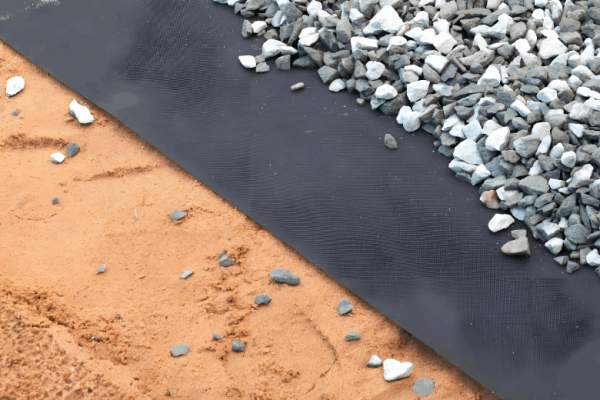Imagine your beautifully laid paver driveway or patio,a significant investment of time and money,beginning to show uneven settling,surface irregularities,or stubborn weeds pushing through the joints within just a year or two.This affects not only the appearance but also poses a safety hazard.Often,the root cause is not the pavers themselves,but a fundamental material in the base layer–geotextile fabric.This article will introduce geotextile fabric for paver applications.
Geotextile fabric is a critical synthetic material in modern civil engineering,playing an indispensable role in paver projects.This guide will comprehensively explain how to use geotextile fabric correctly,from its principles and selection to installation,ensuring your paving project stands the test of time.

Why is Geotextile Fabric Essential Under Pavers?
Geotextile fabric is not an”option”but a”necessity.”It primarily ensures the long-term stability of the project through four core functions:
Separation: This is the most basic and vital function.It acts as a strong”barrier,”permanently separating the upper crushed stone base layer from the lower soft soil subgrade.It prevents the mixing of gravel and soil due to vehicle traffic and rainwater erosion,thereby avoiding base material loss,reduced load-bearing capacity,and ultimately,the sinking of pavers.
Analogy: It’s like laying sand directly on muddy ground—the sand will quickly sink in.But laying a geotextile fabric first creates a stable working platform.
Reinforcement: Geotextile fabric has good tensile strength,allowing it to distribute loads from above(e.g.,vehicle weight).For soft ground or areas requiring high load-bearing capacity(like driveways),it effectively reduces uneven settlement and enhances the overall structural stability.
Filtration: The fabric allows water to pass through freely while effectively preventing soil particles from washing away with the water.This property ensures proper subgrade drainage,prevents water accumulation from softening the base,and stops soil erosion(piping phenomenon)within the base layers.
Weed Prevention: As a physical barrier,geotextile fabric effectively blocks weeds from growing upward from the soil layer.Compared to herbicide sprays,this is a more environmentally friendly and long-lasting solution.
If you are purchasing Geotextile Fabric for Pavers, you can contact us!

What Kind of Geotextile Fabric is Best for Pavers?
Choosing the wrong type of geotextile can lead to functional failure.Here are the key considerations:
| Characteristic | Woven Geotextile | Non-Woven Geotextile |
| Manufacturing Process | Made by interlacing polypropylene or polyester tapes/threads, resulting in a tight, cloth-like structure. | Made from randomly arranged polyester or polypropylene fibers bonded together by needle-punching, resembling felt. |
| Primary Function | High-Strength Separation & Reinforcement | Filtration, Drainage, Cushioning |
| Tensile Strength | High | Medium |
| Permeability | Lower permeability perpendicular to the plane, but good in-plane water flow. | Excellent permeability perpendicular to the plane. |
| Texture/Feel | Smooth, Robust | Soft, Pliable |
| Ideal Application | Driveways, areas subject to heavy traffic, projects requiring high load-bearing capacity. | Walkways, patios, garden paths, areas around drainage systems. |
Key Metrics: Weight and Strength
Weight(g/m²): This is an important reference for selection.For most residential patio projects,a non-woven geotextile fabric weighing 150g/m²to 200g/m²is entirely sufficient.For driveways,it is recommended to use a woven geotextile fabric weighing 200g/m²or higher.

Geotextile Fabric Installation Guide for Pavers
Incorrect installation can significantly reduce the effectiveness of the geotextile fabric.Please follow these professional steps:
Step 1: Site Preparation
Excavate and level the ground according to the design elevation.
Remove all sharp objects(tree roots,stones)and compact the subsoil.
Step 2: Laying the Geotextile Fabric
Roll out the geotextile fabric smoothly over the prepared subgrade.
Ensure sufficient overlap between adjacent fabric rolls,typically 15-30 cm.
Use U-pins(landscape stakes)to secure the fabric to the ground,preventing it from shifting.
Step 3: Adding Base Material
Directly place the crushed stone base layer(usually 5-10 cm thick)onto the secured fabric.
Compact the base material using machinery(e.g.,a plate compactor).Take care to avoid directly damaging the fabric with the machinery.
Step 4: Standard Paver Installation Process
Lay a bedding sand layer on top of the compacted base,then proceed with installing the pavers.
Step 5: Finishing and Curing
After laying the pavers,spread joint sand over the surface,sweep it into the joints,and finally compact gently with a plate compactor to settle the pavers and lock the sand.

Common Mistakes with Geotextile Fabric for Pavers
Mistake 1: Using Plastic Sheeting Instead of Geotextile Fabric:Plastic sheeting is impermeable,creating a”pond”under the pavers that can soften the subgrade and cause frost heave in winter.It is a primary cause of project failure.
Mistake 2: Insufficient Overlap or Lack of Securement:Too little overlap or failure to secure the fabric can cause it to shift during construction,losing its separation function.
Mistake 3: Damaging the Fabric During Base Installation:When dumping gravel,do so from a low height and slowly to avoid large,sharp stones falling from a height and puncturing the fabric.
Expert Advice: When in doubt,follow the”better safe than sorry”principle.Opting for a slightly higher-specification geotextile fabric is a safer investment.

Conclusion
Although geotextile fabric represents a small fraction of the total cost of a paving project,it is crucial for determining the project’s lifespan.Correctly selecting and installing high-quality geotextile fabric is the best guarantee for protecting your investment of time and money.
As a geosynthetics manufacturer with 15 years of professional experience,we are committed to providing customers with products that meet the highest standards.We don’t just sell geotextile fabric;we offer technical support based on extensive project experience.Contact us!
Reference Sources
- ASTM D4439: Standard Terminology for Geosynthetics. Provides precise definitions for terms like “separation,” “reinforcement,” and “filtration,” ensuring conceptual accuracy.
- ASTM D5261: Standard Test Method for Measuring Mass per Unit Area of Geotextiles. Supports the description of the key metric “weight (g/m²).”
- Related Performance Test Standards: Such as ASTM D4632 (Tensile Strength) and ASTM D6241 (Puncture Strength), which underpin the mentions of “mechanical indicators” and “compliance with international standards.”
Frequently Asked Questions(FAQ)about Geotextile Fabric for Pavers
Q1:What weight of geotextile fabric is needed for a garden walkway?
A:Typically,a non-woven geotextile fabric weighing between 150g/m²and 200g/m²is perfectly suitable for garden walkways,providing good filtration and drainage while effectively preventing weeds.
Q2:Is geotextile fabric the same as ordinary landscape fabric(weed barrier)?
A:No.Landscape fabric usually has a lower weight and strength,and is primarily used for weed suppression in decorative areas.Engineering-grade geotextile fabric has defined mechanical and hydraulic properties,designed specifically to withstand loads and harsh conditions.The two are not interchangeable.
Q3:Is geotextile fabric itself waterproof?
A:No,it is not waterproof.Geotextile fabric is permeable.Its core functions are filtration and drainage.If waterproofing is required(e.g.,for pond liners),a geomembrane should be used.















